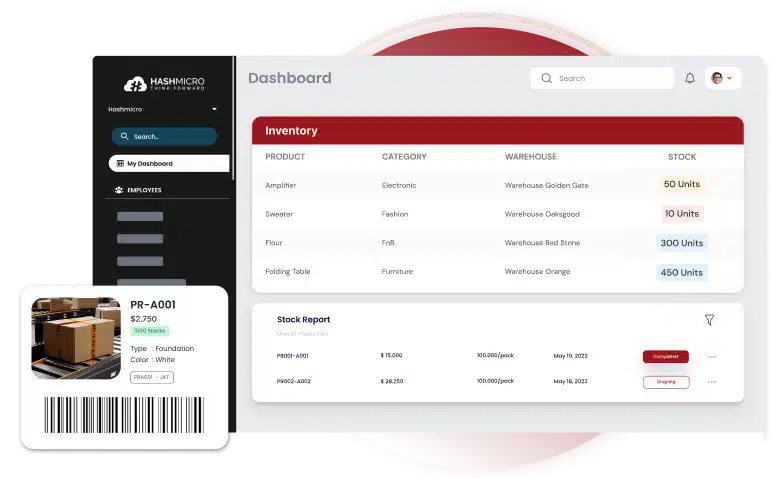If you are a manufacturing, distribution, or retail company, warehouse maintenance is crucial in your supply chain. Ever tried cooking in a messy kitchen? It’s frustrating and inefficient, right? The same goes for a cluttered warehouse, lah!
Neglecting maintenance can lead to drops in productivity, workplace injuries, product damage, and unhappy customers. However, companies that successfully implement predictive maintenance can see a 20%–40% reduction in unplanned downtime and a 10% decrease in the total cost of ownership.
In this guide, we’ll dive into the importance of warehouse maintenance, share best practices, and provide a checklist to keep your equipment in top condition and your work environment shiok.
Key Takeaways
|
What is Warehouse Maintenance?
Warehouse maintenance encompasses various activities to preserve a warehouse’s functionality, safety, and cleanliness. It involves regular inspections, repairs, and upkeep of essential components such as equipment, infrastructure, and operational systems.
Key tasks include conducting routine audits, ensuring machinery runs efficiently, and minimizing clutter to reduce safety hazards. Additionally, maintaining inventory control and monitoring storage conditions play a vital role in preventing operational issues.
Maintaining an organized and functional facility is crucial for carrying out daily warehousing processes efficiently with minimal disruptions, ultimately supporting seamless operations.
Types of Warehouse Maintenance
Effective warehouse maintenance is key to maximizing operational efficiency and minimizing disruptions. Businesses typically engage in several types of warehouse maintenance to ensure smooth operations:
1. Scheduled/preventative maintenance
These activities are planned and carried out regularly to avoid unexpected equipment failures and process disruptions. For instance, machinery might be maintained after every 20 hours of use. Regular clean-up tasks, like trash removal, mopping, or equipment wiping, also fall under this category.
2. Inspections
Regular, comprehensive inspections are vital to spot potential or emerging issues before they escalate into significant problems. Key areas to inspect include:
- Overall cleanliness
- Waste disposal systems
- The receiving process
- Loading dock areas
- Inventory management
- Warehouse safety
- Work environment
- Training practices
Products regulated by local authorities, like the Singapore Food Agency (SFA), should also be reviewed to ensure compliance.
3. Training
A well-maintained warehouse requires skilled workers. Businesses should provide training sessions to help employees understand and safely operate equipment, promoting efficient task performance throughout the team.
Why is Warehouse Maintenance Crucial for Business?

In modern supply chain management, warehouses have evolved beyond simple storage facilities. A well-maintained warehouse plays a vital role in facilitating the smooth movement of goods from suppliers to customers, making it a key element of an efficient supply chain.
Regular, planned maintenance of infrastructure and equipment is crucial to minimizing unexpected breakdowns that could cause costly downtime and disrupt the complex logistics network.
Here are five reasons why a good warehouse maintenance is important for business:
- Reflects Quality Commitment: A warehouse’s condition showcases a company’s dedication to quality. A clean and orderly facility enhances brand perception and meets today’s high consumer expectations.
- Reduces Operational Errors: Proper maintenance minimizes errors in picking, packing, and shipping processes. Interestingly, it can also increase equipment uptime and availability by 10%–20%.
- Boosts Supply Chain Efficiency: Maintenance creates a more reliable supply chain by preventing disruptions and breakdowns, which leads to a 5%–20% reduction in inventory carrying costs.
- Ensures Workplace Safety: Routine inspections and preventive maintenance protect employees by identifying and eliminating hazardous conditions caused by neglected upkeep.
- Protects Valuable Inventory: Regular maintenance checks help safeguard the structural integrity of the warehouse and its equipment, thereby preserving the safety and condition of stored goods.
What a Neglected Warehouse Looks Like
If your warehouse appears to be running smoothly, it can sometimes be difficult to identify when maintenance is overdue. Here are some signs that a business might be neglecting its warehouse upkeep and should allocate time to address these issues:
1. Disorganized and cluttered storage areas
In a warehouse that lacks proper maintenance, storage areas often become disorganized. Storage locations might not be accurately labeled, and equipment like bins, shelves, and pallet racks may be outdated or in poor condition.
This can make locating and picking items more challenging, slowing down fulfillment operations and increasing the risk of inventory loss or misplacement.
2. Build-up of dust and debris
When routine cleaning is neglected, dust and debris start accumulating on floors and workstations. This creates slippery surfaces, making it harder for workers to move around safely and complete their tasks efficiently.
Such conditions can slow down other warehouse operations and potentially lead to delays or safety incidents.
3. Insufficient lighting
Dim, broken, or flickering lights are common in neglected warehouses. Poor lighting not only hampers visibility but also increases safety risks for workers. Inadequate lighting can result in accidents and injuries, impacting overall operational efficiency.
4. Malfunctioning equipment and machinery
Regular maintenance of equipment like forklifts, conveyor systems, and pallet jacks is vital for worker safety. Neglecting this can lead to equipment failures or breakdowns, halting warehousing operations since many tasks rely on functional machinery to be completed effectively.
5. Lack of regular inspections and maintenance
One of the primary reasons warehouses fall into neglect is the absence of regular inspections and maintenance checks. When inspections are delayed or skipped altogether, minor issues can go unnoticed and eventually escalate into major problems.
6. Faulty electrical systems or flammable materials
Unchecked electrical systems and flammable materials left on warehouse floors pose serious safety risks. These hazards can lead to accidents or fires, resulting in potentially catastrophic damage that would be extremely costly to address.
Dangers of a Neglected Warehouse

Every warehouse requires a layout that ensures the efficient movement of products, starting from their arrival and storage to picking and loading for distribution. To support this process, most warehouses are equipped with:
- Shelving and Racking Systems
- Climate Control Systems
- Inventory Management Systems
- Various Equipment: This includes forklifts, service carts, pallet jacks, cranes, and monorails to assist in handling products or heavy boxes within the warehouse.
Routine maintenance is crucial here. Without proper upkeep, a warehouse will eventually turn into a hazardous workplace.
- Forklift Accidents: It’s not uncommon for operators to accidentally bump forklift trucks into pallet rack beams while managing random loading tasks. If damaged racks aren’t promptly repaired or replaced due to a lack of preventive maintenance, they can suddenly collapse, potentially injuring any workers nearby.
- Operational Disruptions: Operational issues can be just as severe as safety concerns. Consider what happens when a belt in your conveyor system decides to malfunction. The entire operation can grind to a halt, resulting in chaos, shipping delays, canceled orders, and, in the end, financial loss.
Regular and timely maintenance can prevent conveyor belts from unexpected breakdowns (or at least make them less frequent), minimizing or even eliminating downtime.
Challenges of Warehouse Maintenance
When establishing preventive maintenance procedures in your warehouse, you may encounter a few obstacles. Let’s briefly discuss these challenges so you know what to expect and how to avoid them.
1. Poor warehouse layout and organization
A cluttered and disorganized warehouse can quickly become a maintenance nightmare. In such an environment, maintenance and repair tasks may be delayed, or worse, create safety hazards and cause significant operational disruptions.
While you can’t change the overall layout overnight—like the path from the loading dock to storage to the shipping dock—you can improve the organization by using labels, signage, maps, and properly categorizing and compartmentalizing inventory.
This organization makes it easier for maintenance technicians to locate broken equipment and necessary tools without sifting through piles of items. Implementing inventory management and asset or facility management software can help eliminate these inefficiencies.
2. Finding the right time for maintenance
Warehouses, particularly distribution centers, are bustling with workers and activity around the clock, making it challenging to find an appropriate time for maintenance work. Planning ahead is essential to schedule maintenance at a time that minimizes disruptions.
One strategy is to divide the warehouse into different sections or blocks, with each block undergoing maintenance on a separate day when expected to have the least traffic.
It’s also crucial to inform all affected workers about the timing and location of the upcoming maintenance to ensure smooth operations.
3. Limited time window for repairs
Different warehouses have varying levels of tolerance for operational delays. For example, a public warehouse operating at half capacity may be able to handle a two-hour delay due to equipment failure without severe consequences.
On the other hand, a similar delay in a semi-automated Amazon warehouse could frustrate hundreds of e-commerce customers waiting for their same-day delivery.
In high-demand environments, clear emergency procedures and a trained response team are essential. A mobile, cloud-based warehouse management system can quickly report issues and coordinate resources for fast repairs.
Warehouse Maintenance Best Practice

When implementing warehouse maintenance procedures, following best practices can make a significant difference in efficiency and safety. Let’s go through these key practices to help keep your warehouse in top condition.
1. Establish a preventive maintenance plan
Implementing a preventive maintenance program is essential for smooth warehouse operations. Follow these steps:
- Identify Equipment: List all equipment and systems requiring regular maintenance.
- Collect Equipment Data: Gather necessary information to create a practical maintenance schedule, such as make, model, serial numbers, warranties, maintenance logs, and OEM recommendations.
- Develop a Maintenance Plan: Collaborate with warehouse managers, engineers, and technicians to establish a maintenance schedule for each piece of equipment, incorporating regular inspections and checks.
2. Schedule regular inspections and maintenance
Routine inspections and preventive maintenance are vital to catching potential issues early. Work with your team to develop a schedule for equipment and full warehouse inspections, ideally during low-traffic periods like weekends or breaks to minimize disruptions.
If this isn’t feasible, remember that short, planned interruptions are far better than unexpected, lengthy shutdowns due to emergency repairs.
3. Standardize tasks and procedures
Warehouse operations involve repetitive tasks, making it beneficial to create standard operating procedures (SOPs) for both maintenance and other daily activities. Include maintenance checklists and Lock-Out Tag-Out procedures to promote safety and consistency.
Use labeling, signage, and inventory compartmentalization to keep the warehouse organized, aiding maintenance personnel in quickly finding necessary tools and equipment. Implementing barcode tracking software can further enhance organization by providing real-time tracking of equipment, ensuring that maintenance teams can efficiently locate assets that need servicing.
4. Implement a warehouse management system (WMS)
Using modern warehouse management software can greatly streamline maintenance operations. A good WMS allows you to:
- Report equipment issues quickly.
- Track asset location and condition.
- Manage PPE, tools, and spare parts inventory.
- Coordinate work orders among multiple teams.
- Schedule and optimize maintenance for numerous pieces of equipment.
- Maintain compliance with safety regulations.
- Track maintenance costs related to vendors, contractors, parts, and labor.
Additionally, a robust WMS provides detailed analytics and reporting, enabling you to monitor performance and identify areas needing maintenance. Choose your WMS wisely to automate manual tasks and improve overall warehouse efficiency.
One of the best WMS in Singapore is HashMicro. Not only does it offer all the essential features for seamless warehouse maintenance, but it also adapts to your business’s unique needs.
Curious about how cost-effective it can be? Try out the WMS pricing calculator to explore options that could fit your budget perfectly.
5. Train staff on maintenance awareness and safety protocols
Your staff works directly with warehouse machinery, so training them on maintenance importance and safety protocols is crucial. Organize seminars to educate them on identifying potential issues and the procedures for troubleshooting.
6. Keep the warehouse clean and organized
Routine cleaning is a key part of maintenance. Implement protocols to ensure workers place items in their designated locations and keep tools properly stored. Consider having a dedicated maintenance team handle tasks like mopping, dusting, disinfecting, and trash disposal to maintain a clean, safe work environment.
7. Focus on continuous improvement
Even the best maintenance strategies can be improved. Regularly review and update your maintenance plans based on operational needs, employee feedback, and performance data.
Make incremental adjustments, such as refining schedules to reflect current maintenance demands better and enhance efficiency without overwhelming the team.By following these practices, you can establish a robust maintenance plan that keeps your warehouse running efficiently and safely.
Effortless Warehouse Maintenance Using HashMicro Warehouse Management Software

Incorporating the right technology into warehouse operations can significantly enhance maintenance and safety. HashMicro’s Warehouse Management System goes beyond just managing inventory; it optimizes your warehouse’s overall efficiency while simplifying maintenance activities.
For instance, HashMicro’s WMS helps organize warehouse layouts and streamline inventory storage for faster, safer picking. With 100% unlimited users, this software is more than capable of accommodating your warehouse’s growth.
How can HashMicro Warehouse Management System do all these? Simple, lah. It has these nifty features to help:
- Putaway Capacity Checking: This one checks if the shelves can handle the load, so you don’t overload them and risk accidents. Keeps everything safe and avoids unnecessary repairs later, lah.
- Warehouse Pallet Racking: Properly organizing your racks makes a big difference, lah. You can categorize them based on type and function, making it easier to access items and keeping the warehouse tidy. Less clutter, less trouble!
- Racking Capacity with Putaway Strategy: This feature gives smart recommendations for where to place your goods. When things are stored properly, it’s way easier to clean, inspect, and fix stuff. More efficiency, less headache, right?
- Stock Optimizer per Warehouse: This one shows how full the warehouse is and helps you plan the best way to store items. It keeps things organized and reduces clutter, so maintenance work can be done smoothly.
- Warehouse Reporting: The reporting tool gives you clear data on what’s working and what needs fixing. You can spot problems early and take action before they become a big issue. Better to catch it early, hor?
The better news is that this WMS has a high-quality interface, which is designed to be intuitive and easy to navigate. The system provides step-by-step guidance with visuals, helping your team carry out essential functions smoothly.
Conclusion
Warehouse maintenance is essential for safety, efficiency, and seamless daily operations. It involves regular inspections, equipment repairs, and organized storage to prevent disruptions. By maintaining their warehouses well, businesses can meet customer demands while safeguarding employees and inventory.
HashMicro’s WMS is the best solution for good warehouse maintenance and productivity. With its advanced features, your warehouse stays organized and clutter-free. Plus, the intuitive interface makes it so swee for your staff to navigate and manage everything without any stress.
The best part? This software scales with your business, offering unlimited users for effortless growth. Say goodbye to maintenance headaches and hello to smooth, efficient operations.
Try out the free demo and bring your warehouse to the next level; steady, right?
Warning: Undefined array key "med" in /home/hashmicr/public_html/blog/wp-content/plugins/insert-headers-and-footers/includes/class-wpcode-snippet-execute.php(419) : eval()'d code on line 281















